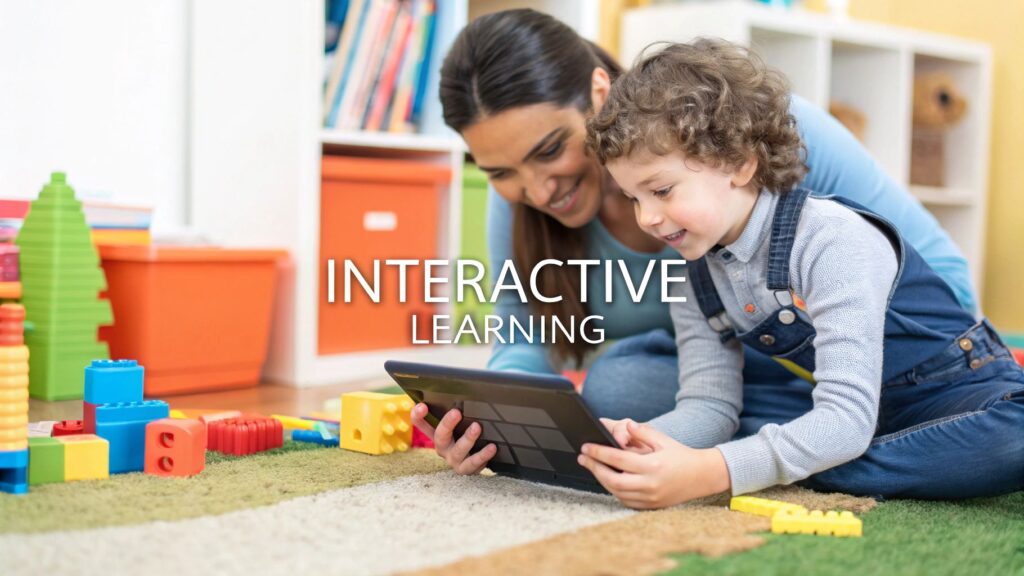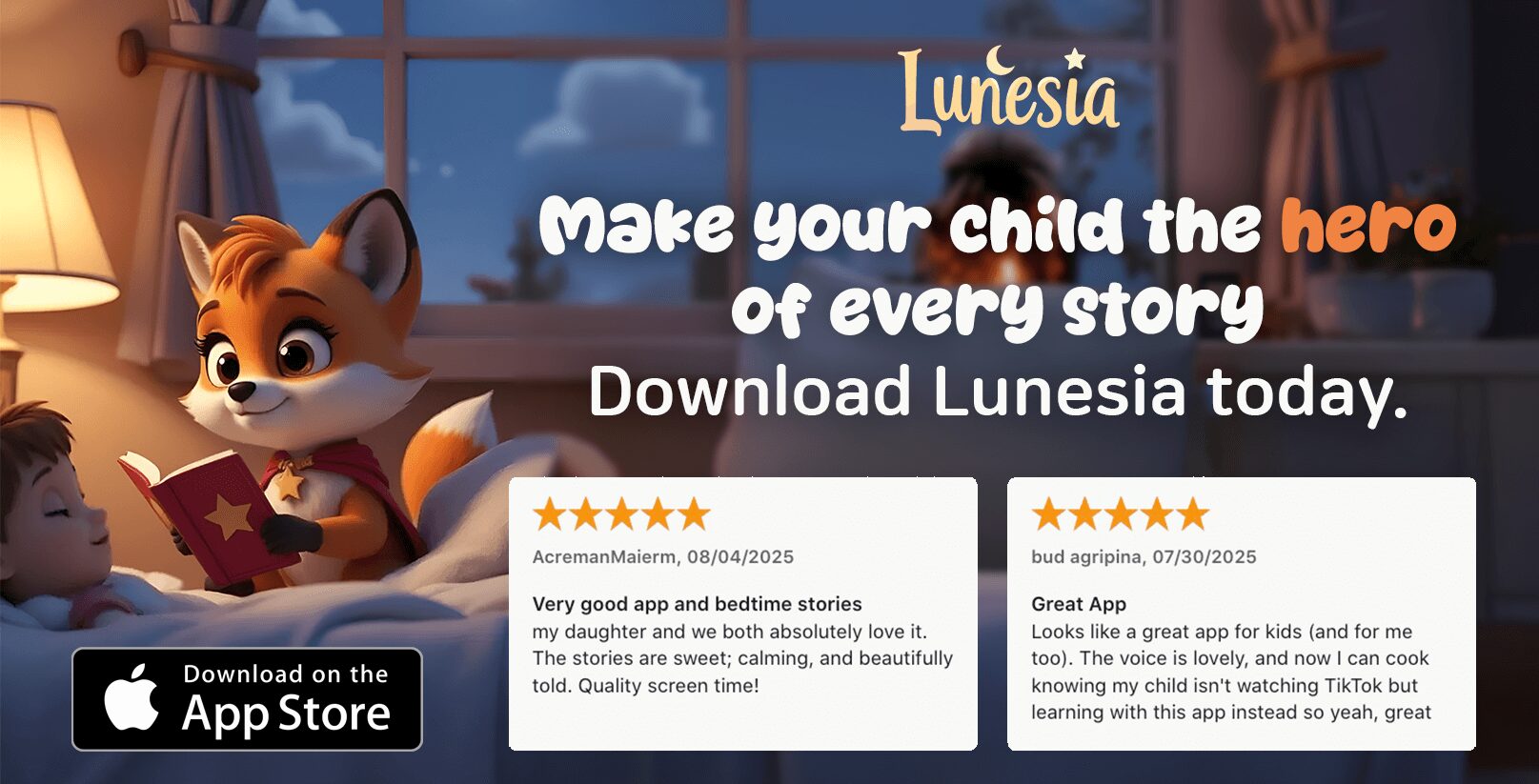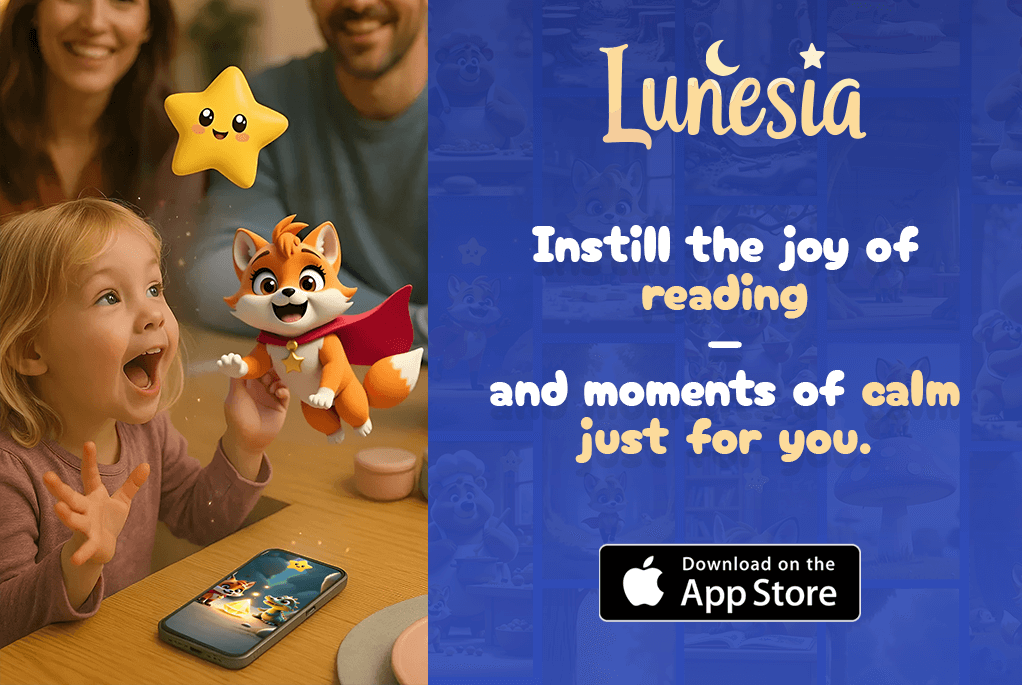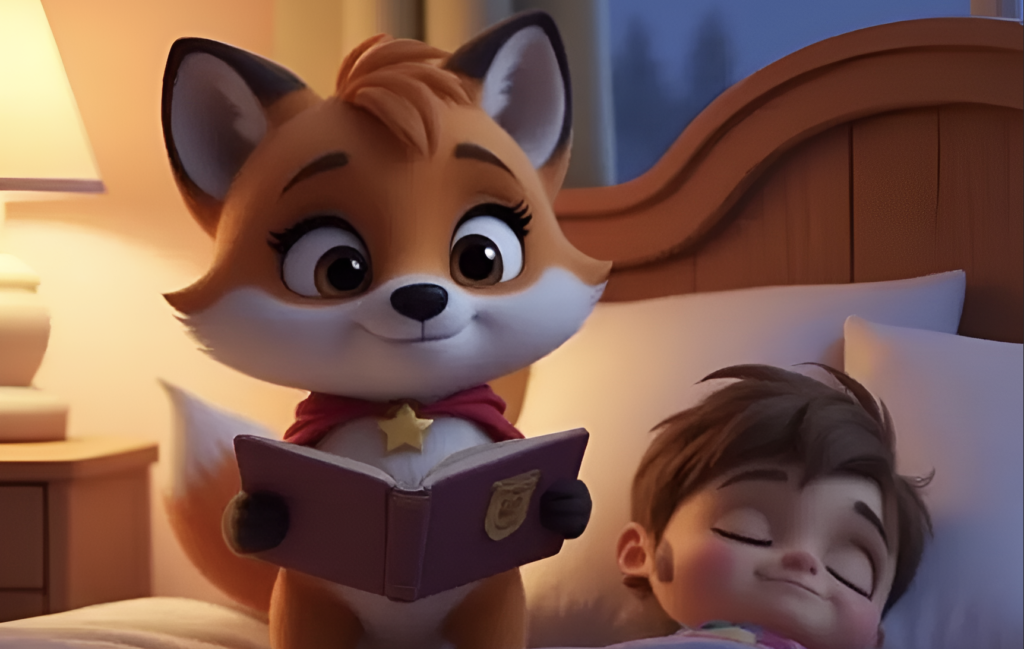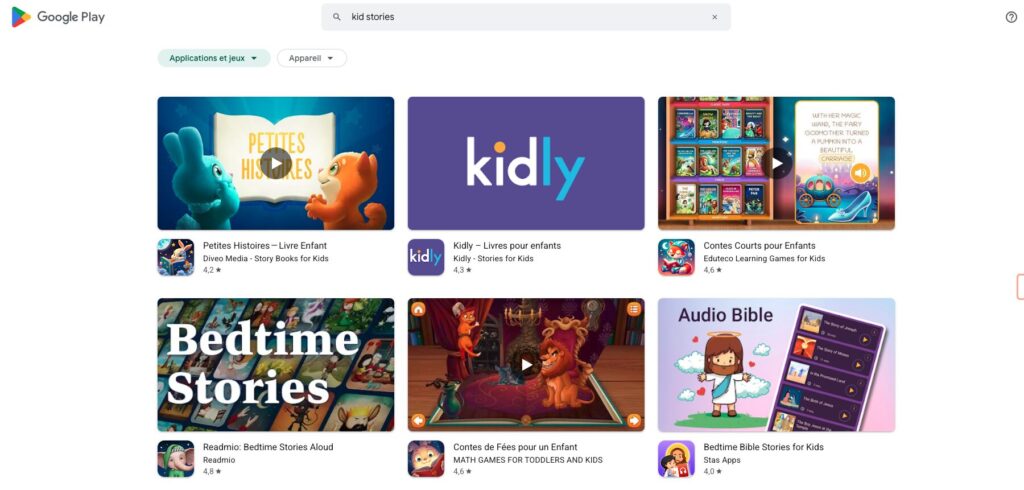Ever feel like you're talking, but the important lessons just aren't sinking in? You're not alone. Let’s have a little coffee chat about a secret weapon in every parent’s toolkit: interactive learning. So, what is it, really?
At its heart, it’s the simple but game-changing shift from passively watching to actively doing.
Imagine the difference between your child watching a show about gardening versus actually getting their hands dirty, planting a seed, and watering it themselves. It's less about a lecture and more about a shared adventure where they become the hero of their own discovery.
Passive vs. Interactive Learning at a Glance
Wondering what this looks like in your busy day-to-day life? To really see the difference, it helps to compare everyday activities side-by-side. The table below breaks down how a simple shift in your approach can turn a passive moment into a powerful, brain-building opportunity.
| Activity | Passive Learning (Watching) | Interactive Learning (Doing) |
|---|---|---|
| Storytime | Listening to a story being read aloud. | Choosing the story's direction; "What should the character do next?" |
| Building Blocks | Watching you build a cool tower. | Building a tower together, asking "Which block will make it stronger?" |
| Art | Looking at a finished painting. | Mixing colors, choosing brushes, and creating their own masterpiece. |
| Nature Walk | Being told the names of different trees. | Collecting different types of leaves and sorting them by shape or color. |
See the pattern? Interactive learning isn't about adding complexity, but about adding choice. It's about empowering your child to think, decide, and act, which is the secret sauce for learning that actually sticks.
The Secret to Learning That Actually Sticks
Think back to that gardening example. Which experience will your child remember more vividly a year from now? The TV show, or the feeling of the soil and the pride of seeing that first sprout pop up? Interactive learning is that messy, hands-on, and deeply effective process of making choices and seeing what happens next.
This isn't about flashcards or stressful lessons. It’s a minds-on approach that turns everyday moments into powerful growth opportunities—a true partnership between your child's boundless curiosity and the world around them.
Interactive learning is the single most powerful way to build not just knowledge, but also unshakable confidence. When children see their choices matter, they learn to trust their own judgment and feel empowered to solve problems.
Turning Play into Progress
So, how do you make this happen without turning your home into a preschool classroom? It’s simpler than you might think.
When you ask your toddler, "Should we put the red block or the blue block on top?"—that's interactive learning in action. When your five-year-old decides which path a character should take in an interactive story, they're not just playing; they're practicing critical thinking and empathy.
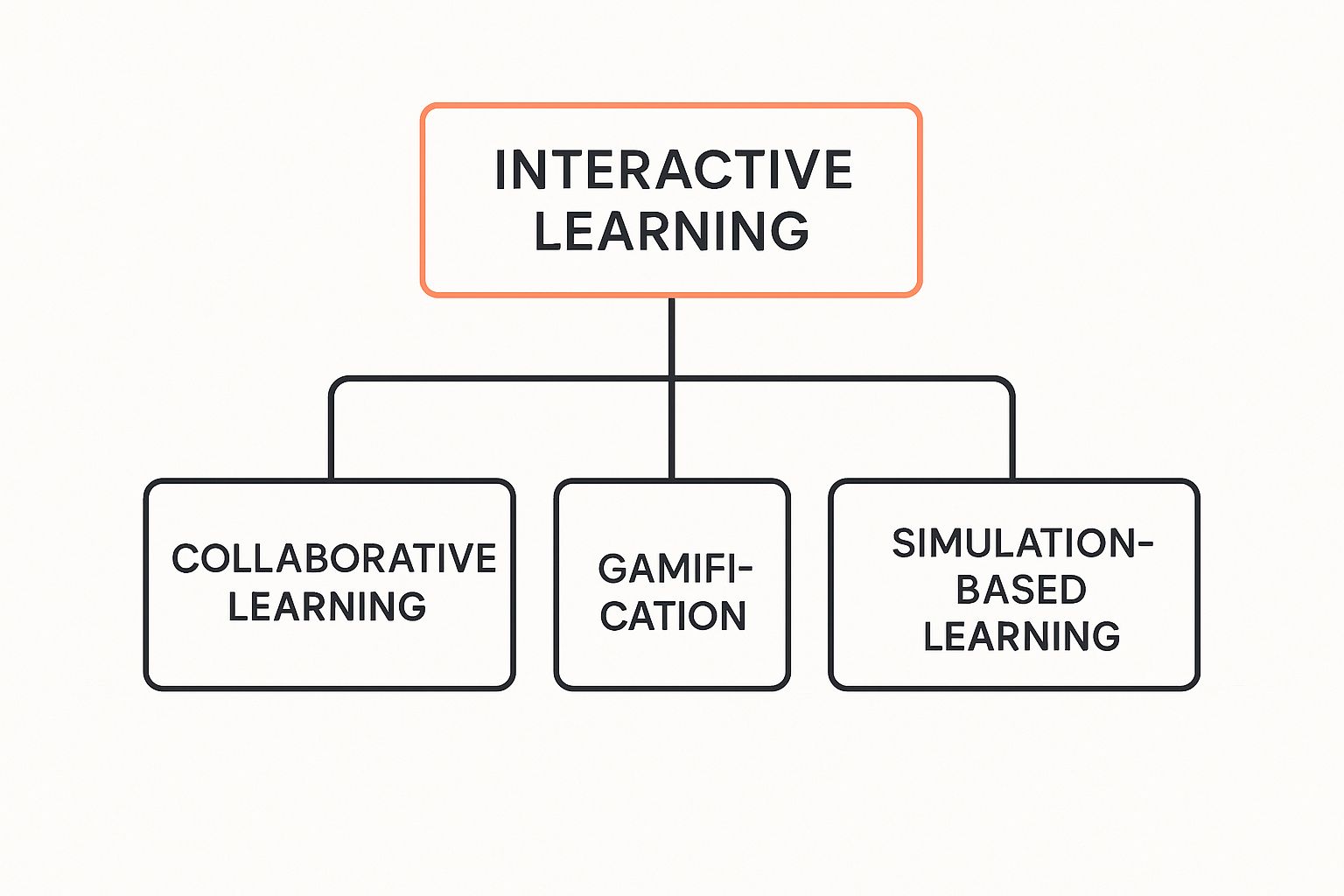
Concepts like collaboration and gamification are central to this approach, turning education into an engaging experience rather than a chore. And the results speak for themselves. In fact, research shows that children exposed to hands-on learning are significantly more likely to improve their comprehension and long-term memory.
Smart Tools for Modern Parents
This is where thoughtfully designed apps can be an absolute game-changer. Tools like Lunesia offer a universe of interactive stories where children don’t just listen; they make decisions that shape the adventure.
These aren't just digital bedtime stories—they’re engaging journeys that teach kindness, courage, and problem-solving in a safe, ad-free environment. While it’s certainly different from unstructured playtime, it serves a unique and valuable purpose. You can explore a deeper comparison between interactive learning and free play in our guide.
The Science Behind Why It Works
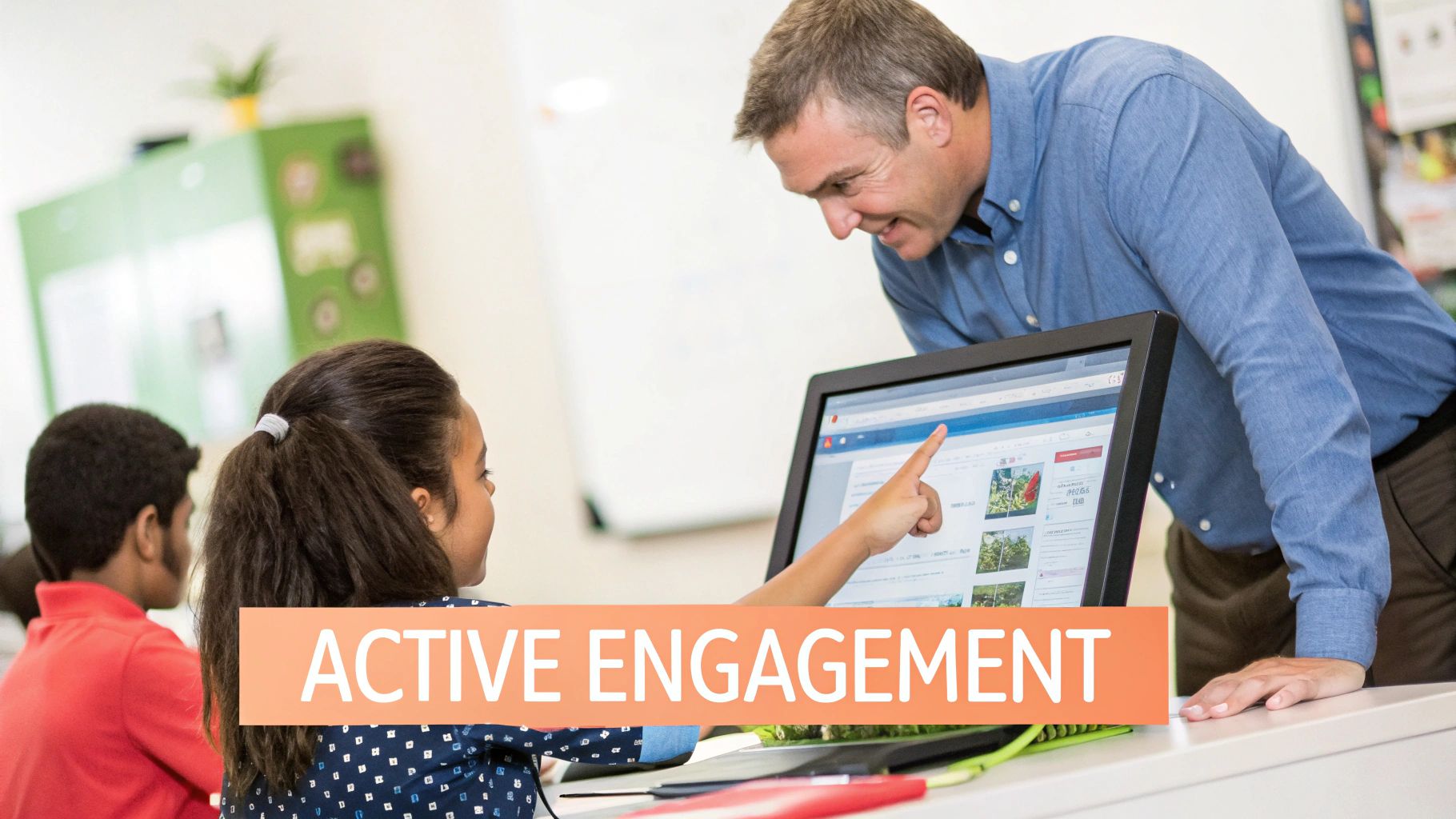
Have you ever noticed how a child can remember every single Pokémon but can’t recall what they ate for breakfast? It’s not their memory; it’s about how their brain was engaged. This is the real magic behind interactive learning—it's not another educational trend, but a powerful method rooted in brain science.
When a child is passively watching a cartoon, their brain is mostly just taking in information. But the moment you ask, "What do you think happens next?" everything changes. Their brain lights up, forging and strengthening the neural pathways needed for problem-solving, decision-making, and critical thinking. It’s the difference between watching someone do a push-up and actually getting on the floor and feeling your muscles work.
Building an Emotional Toolkit
But interactive learning goes way beyond the ABCs and 123s. It’s an incredible training ground for emotional intelligence. How do you explain a big idea like "courage" to a four-year-old who’s terrified of the dark? Or teach empathy when they’ve just snatched a toy from their friend? Abstract concepts are tough for little minds to grasp with words alone.
This is where interactive stories come in. They let children practice these feelings and behaviors in a safe, controlled space. In a Lunesia adventure, when your child guides a character to be kind to a grumpy gnome or brave in a spooky cave, they aren't just tapping a screen. They are rehearsing real-world emotional responses, building a mental library of solutions for when they face their own big feelings. This active participation helps them develop something called cognitive flexibility, a crucial skill for adapting to new situations and thriving in life.
The greatest benefit of interactive learning is that it moves beyond memorization. It builds resilient, thoughtful, and confident children by letting them safely explore the consequences of their choices, one story at a time.
The Power of "Doing" for Long-Term Memory
Think about it: which sticks with you more—reading a recipe or actually baking the cake? Interactive learning creates much stronger, stickier memories because it engages multiple parts of the brain at once. When a child makes a choice and sees an immediate result, their brain releases dopamine, a chemical messenger linked to pleasure and memory formation.
This “learn-by-doing” method is quickly becoming a cornerstone of modern education. In fact, research shows active learning can boost student performance by more than 30% compared to traditional lectures. It's why modern educational tools are so effective.
Research also highlights how specific tools, like AI-generated video quizzes for classroom learning, can dramatically boost engagement. Apps like Lunesia use this very same principle, turning what could be passive screen time into a powerful tool for building real skills. While your child is immersed in a safe, ad-free world, making choices and learning values, you get a moment of peace—guilt-free. You can dive deeper into how interactive play boosts cognitive flexibility in our detailed article.
Bringing Interactive Learning Home
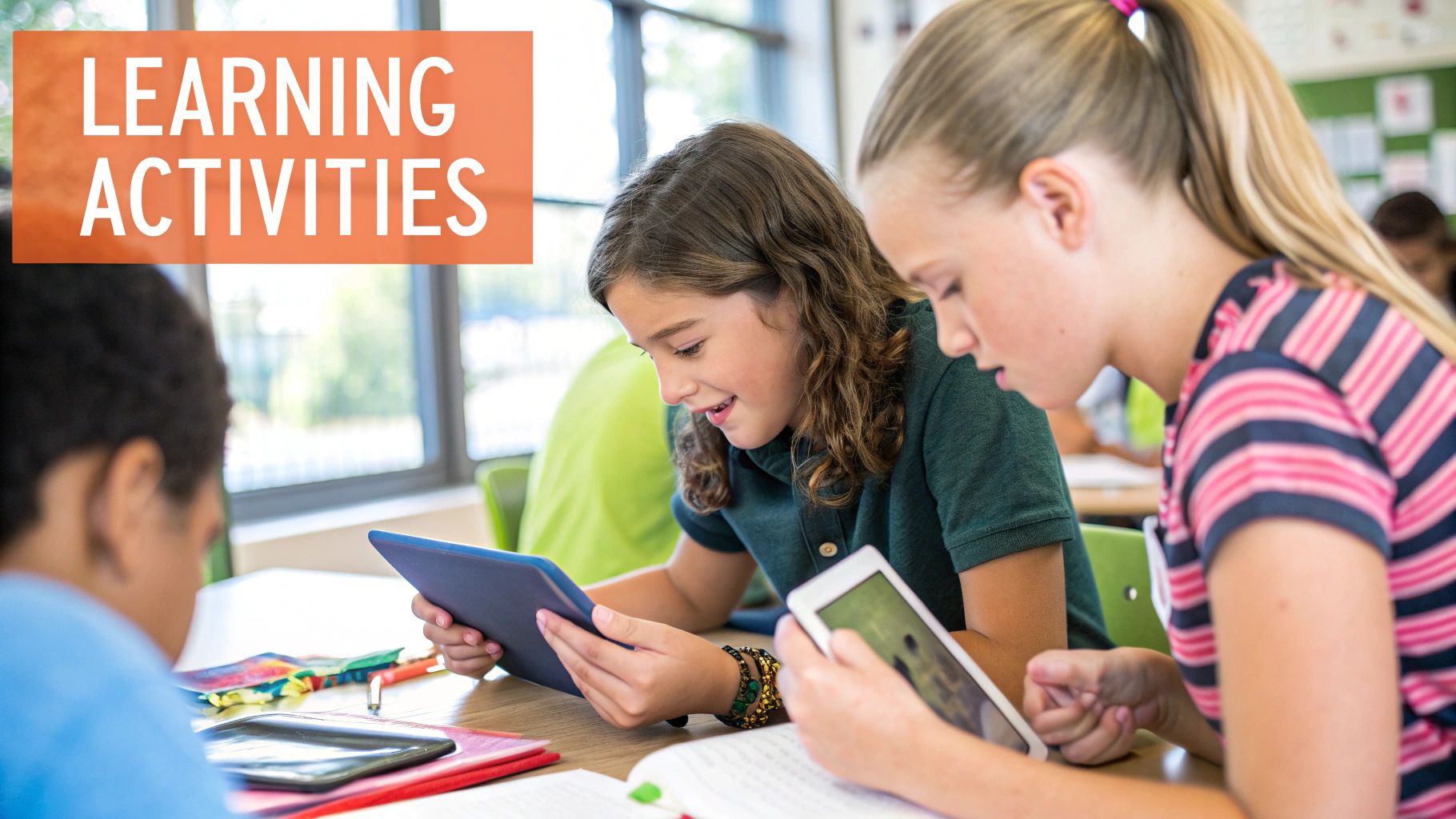
Does the thought of "hands-on learning" at home conjure images of glitter explosions and kitchen experiments gone wild? Take a deep breath. You don't need a cleanup crew or a degree in early childhood education to bring interactive learning into your daily life.
In fact, you’re probably already doing it.
It all starts with small, simple shifts in how you talk and play together. Instead of just telling your child what to do, you invite them to be a co-pilot in their own day. The real secret is turning everyday routines into delightful little "what if" moments.
Simple Swaps for a Big Impact
Curious about how to make this happen? It’s all about creating opportunities for your child to make small, meaningful choices. This builds their confidence and teaches them that their voice actually matters.
Here are a few easy ideas you can try today:
- The Decision-Making Walk: On your next stroll, pause at a corner and ask, "Should we turn left toward the big oak tree or right toward the park?" Let them lead the way and see where your mini-adventure takes you.
- Collaborative Dinner Stories: Stuck for dinner conversation? Start a story with a simple line like, "Once there was a brave squirrel who found a giant acorn…" Then, pass the story to your child. Their only job is to add the next sentence.
- Sorting the Laundry: Turn a chore into a game. Ask your child to help you sort laundry not just by color, but by texture. "Can you find all the soft, fuzzy socks?" or "Let's make a pile of all the bumpy towels."
These tiny moments are where the real magic happens. They are powerful, real-life examples of interactive learning that require zero prep and no mess.
You don't need a perfectly planned activity to teach valuable lessons. The most impactful learning often comes from spontaneous questions that empower your child to think for themselves and see the world as a place full of choices.
Want to make this a regular habit? It's easier than you think. Here’s a sample schedule to sprinkle these small, powerful moments throughout your week without adding any stress to your plate.
Simple Interactive Activities for Your Week
| Day | Quick Activity (10-15 mins) | Key Skill Developed |
|---|---|---|
| Monday | Let your child choose their snack from two healthy options. "Apple slices or yogurt today?" | Decision-Making |
| Tuesday | During bath time, ask them to predict which toys will sink and which will float. | Critical Thinking |
| Wednesday | While getting dressed, have them pick their own outfit (within reason!). | Independence |
| Thursday | Ask them to "read" a picture book to you by telling the story in their own words. | Narrative Skills |
| Friday | Build a small fort with pillows and blankets together, letting them direct the construction. | Problem-Solving |
See? We're talking about small, manageable additions to things you're already doing. The goal isn't to become a full-time teacher; it's to find pockets of connection that build your child's brain and confidence.
When Screen Time Becomes Smart Time
Let’s be real—sometimes you just need a moment. But what if screen time could offer the same benefits of choice and consequence, all while giving you a much-needed break? This is where a tool like Lunesia becomes your secret weapon.
Instead of passively watching a show, your child steps into the role of the hero. They get to decide if the main character should share their treasure, face a fear, or help a friend in need. Each choice shapes the story, teaching them about courage, kindness, and problem-solving in a beautifully crafted, ad-free world.
It transforms screen time from a passive distraction into an active, value-rich experience. While your child is immersed in a meaningful adventure, you gain precious moments for yourself without a shred of guilt, knowing they are safe and learning. If you're looking for more ways to blend digital tools into your family's life, check out our guide on how to incorporate educational apps into your daily routine.
From Storybook Fears to Real-World Courage
Think about a common childhood fear, like being afraid of the dark. It’s a tough one to reason your way out of. But what if your child could guide a little firefly character through a dark forest, making choices to help it find its way home?
In a Lunesia story, your child might be asked to decide:
- Should the firefly hide behind a bush, or should it shine its light brightly to see what’s ahead?
- Should it ask a friendly-looking owl for directions, or try to find the path all by itself?
Each decision is a tiny, safe exploration of courage. They get to see the cause and effect of being brave without any of the real-world risk. They’re building a mental toolkit, so when their own anxieties creep in at bedtime, they have a successful experience to draw from. It’s a subtle but powerful way to teach emotional resilience.
By letting children act out challenging scenarios within a story, you give them the vocabulary and confidence to manage their own emotions. Lunesia becomes a partner in parenting, helping you teach the crucial skills that are often so hard to put into words.
These stories aren't just entertainment; they're thoughtfully designed to address the very challenges you face every day. From navigating a tantrum to overcoming a bout of shyness, these adventures offer a safe playground for emotional growth.
And the bonus for you? While your child is deeply immersed in a meaningful, ad-free adventure, you get a moment. You can finish your coffee, answer that one last email, or just take a deep breath. You can relax knowing they aren’t just occupied—they are safe, happy, and learning how to become a more resilient little person. It’s a guilt-free win for everyone involved.
Preparing Your Child for a Changing World

How do you prepare your child for a world that’s changing faster than we can keep up? It’s a question every parent asks. The skills they'll need for jobs that don't even exist yet won't come from memorizing more facts. The real answer lies in nurturing something much deeper: adaptability, creativity, and the confidence to tackle new problems head-on.
This is where interactive learning truly shines. By inviting children to make choices and see the results, you’re not just teaching them for today—you’re giving them the mental agility for a lifetime of tomorrows. You're building a foundation for success in a world where thinking on your feet is the ultimate superpower.
Technology as a Thoughtful Partner
Smart technology isn't just about flashy games; it’s about personalization. The best tools can adapt to your child’s unique pace, offering a gentle nudge when they’re ready for a challenge and support when they need it most. This thoughtful approach helps build resilience, teaching them that it’s okay to try, stumble, and try again.
To really get our kids ready for what's next, we need to understand how modern tools like AI are shaping education. Exploring practical AI lesson planning strategies shows just how much these tools can boost engagement and make learning stick.
In a world of constant change, the greatest gift you can give your child is not a set of answers, but the curiosity and confidence to find their own.
Artificial intelligence is already making this happen, delivering personalized and adaptive educational experiences. A stunning 86% of educational organizations are already using AI tools that support this kind of interactive learning, recognizing its power to prepare students for the future.
Building Timeless Values for a Modern World
While technology moves at lightning speed, core human values never go out of style. This is where a tool like Lunesia becomes a forward-thinking partner for your family. Its interactive stories use engaging, personalized adventures to instill kindness, courage, and empathy—the very skills that will help your child thrive, no matter what the future holds.
When your child helps a character solve a problem or show compassion, they’re doing more than just playing a game. They’re practicing how to be a good human. Lunesia’s safe, ad-free space gives them the freedom to explore these complex social and emotional ideas at their own pace.
Ultimately, by embracing interactive methods, you are building something far more valuable than a walking encyclopedia. You're raising a curious, adaptable, and kind person who is ready for anything.
Your Guide to Guilt-Free Screen Time
Let’s be honest for a moment, just between us. Parenting is incredible, but man, is it exhausting. Have you ever just wanted five solid minutes to drink your coffee while it's still hot? Or maybe just to hear your own thoughts for a change? Of course, you have. We all have.
But then the guilt sneaks in. Is turning on a screen just a parenting shortcut? A compromise? What if we could flip that script entirely?
Imagine screen time not as a concession, but as a strategic tool that benefits the whole family—one that gives your child a powerful, engaging learning experience while you finally get to recharge.
The Win-Win of Interactive Adventures
This is where the right kind of screen time becomes your secret weapon. When your child is immersed in an interactive story, they aren't just zoning out in front of cartoons. Far from it. They're actively making decisions, solving problems, and building character.
That’s the incredible bonus of an app like Lunesia. While your child is deep in a safe, ad-free adventure—learning about kindness from a friendly dragon or courage from a lost star—you gain that precious time back for yourself.
That break isn't just for you; it's for your family. A rested, recharged parent is a more present and patient parent. Knowing your child is safe and genuinely thriving allows you to take that time without an ounce of guilt.
Think of it this way: instead of just being occupied, your child is on a mission. They are the hero of their own story, navigating challenges and learning crucial life lessons along the way. They might be practicing empathy by helping a sad character or flexing their problem-solving muscles to build a magical bridge.
Meanwhile, you get to catch your breath. You can tackle that one thing on your to-do list that’s been nagging you, or just sit in blessed silence for a few minutes. It’s a true win-win. Your child is learning and growing in a meaningful way, and you are getting the space you need to be the best parent you can be.
Answering Your Top Questions About Interactive Learning
As you start to think about what interactive learning really is, a few common questions always seem to bubble up. Let's tackle them head-on, so you can feel excited and confident about bringing these powerful methods into your family’s routine.
At What Age Can My Child Start?
Are you wondering if your toddler is too young for this? I get it. The truth is, interactive learning starts from day one! Think about it: simple, responsive games like peek-a-boo are the purest form of this in action.
When it comes to digital tools, the sweet spot often begins around age two.
This is when little ones can start making simple choices, turning a regular storytime into an adventure where they feel totally in charge. In an app like Lunesia, a two-year-old can decide which path a character takes, making them the active hero in their own tale.
Is This Really Better Than Just Watching Cartoons?
Absolutely, and the difference is huge. Watching cartoons is a passive experience—information just flows in one direction, right at your child.
Interactive content, on the other hand, demands participation. It nudges your child to think, solve little problems, and make decisions. This active engagement has been shown to fire up cognitive development and build skills that last a lifetime.
How Do I Find the Right Balance?
This is the big one for most parents. The key is to think of hands-on activities and digital learning not as competitors, but as the perfect team.
Use messy play and outdoor adventures for all that amazing sensory exploration. Then, turn to a tool like Lunesia for structured storytelling and emotional learning when it's time to wind down. A healthy, joyful mix is the secret sauce for well-rounded development.
Ready to turn screen time into a meaningful, guilt-free adventure? Discover how Lunesia can help your child build courage, kindness, and confidence, one story at a time. Try Lunesia for free and start your first interactive journey today!
